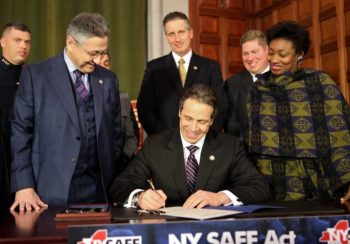
January 15, 2013, Albany – Governor Cuomo signs groundbreaking legislation that will give New Yorkers the toughest protections against gun violence in the nation.
Congress and many states face political obstacles in passing gun controls. But in states where there are no such political obstacles like New York, existing gun control laws remain unimplemented and unenforced. Proponents of gun laws nevertheless argue that the next law will have a big impact. Gun control requires more than passing laws; gun laws must be effectively implemented and enforced. Often they are not.
Consider New York’s SAFE (Secure Ammunition and Firearms Enforcement) Act that, in January 2013, sailed through the State Legislature, without debate or compromises in the wake of the December 2012 Sandy Hook Elementary School massacre. Governor Andrew Cuomo and gun control advocates hailed the SAFE Act as the toughest gun control law in the nation. The new law (actually a basket of laws) came only a decade after New York passed a predecessor “toughest” gun control law in the nation in 2000. And prior to both toughest-in-the-nation gun laws New York was already one of the nation’s strongest gun control states.
The SAFE Act immediately ran into implementation and enforcement difficulties. The provision limiting ammunition loading magazines to seven rounds had to be abandoned because there are no such magazines to fit most popular firearms models. The SAFE Act’s drafters either didn’t know that or didn’t care since the point of the law was to demonstrate the governor’s values. In any event, a federal court struck down as irrational the provision that set maximum magazine capacity limitation. The seven round capacity limitation was withdrawn and replaced by a ten round maximum capacity rule, with the proviso that no magazine could be loaded with more than seven rounds. A federal court struck down that proviso as irrational and in violation of substantive due process.
The provisions regulating ammunition sales and purchases were abandoned. The technical (software) obstacles could not be overcome, at least not at a reasonable cost.
The earlier 2000 New York law (like the 1994 federal assault weapon ban) prohibited weapons that have more than one military-like features and required owners to register with the State Police. The registration requirement achieved only an estimated ten percent compliance.
The requirement that previously licensed-for-life gun owners renew their licenses every five years was made pointless by lack of capacity to check the backgrounds of the hundreds of thousands of applicants. As a result everyone who applied for renewal was automatically approved.
The SAFE Act’s provision that extended background checks to private transactions faltered on very low compliance. The criminal provisions providing enhanced punishments for regulatory violators went almost completely unenforced.
The only provision that was successfully implemented was the one requiring mental health professionals to report to county officials the names of patients perceived to be mentally ill and dangerous. If the county official agrees (and, not having seen the patient, they have no basis for disagreeing), the patient is then reported to the New York State Department of Mental Health and added to database of persons disqualified from gun purchasing or possessing a gun. The patient whose name is reported, however, does not have to be notified. The extent to which the reported patients have been or are separated from their guns or prevented from acquiring new guns is unknown.
Outside of New York City, county officials criticized the SAFE Act as an unfunded mandate. The sheriffs association criticized the law, and some sheriffs announced that they would not actively enforce it.
In retrospect, the SAFE Act looks like an exercise in symbolic politics. The Act was stillborn due to poor design, a failure to provide funds for implementation and enforcement, and the absence of a state-level agency capable of implementation, enforcement and evaluation. In the final analysis, law in action is far different from law on the books.
By: James B. Jacobs. James B. Jacobs is the Chief Justice Warren E. Burger Professor of Law at New York University and is coauthor with Zoe Fuhr of The Toughest Gun Control Law in the Nation: The Unfulfilled Promise of New York’s SAFE Act (NYU Press 2019)


Here’s an easy, no-cost way for everyone to make a REAL difference in the lives of those traumatized by gun violence. Join the National Sing-In Against Gun Violence on the first, annual Requiem and Remembrance Day on March 8, 2020.
Through our collective songs and remembrance we’ll pay tribute to those who have been lost, and offer solace, support and solidarity to the bereaved.
Plenty of no-cost live and online ways for you to “add your voice” even if you can’t carry a tune!
Our mission is to:
• Create a day of unity and healing through music by “crowd-sourcing” love.
• Provide all Americans the opportunity to express their sadness about the terrible toll that gun violence has taken on our families and communities.
• Through our collective songs pay tribute to those who have been lost, and offer solace, support, and solidarity to the bereaved.
• Create a new dialogue gun violence that is outside of politics and conflict.
All voices needed!
Singer4Change